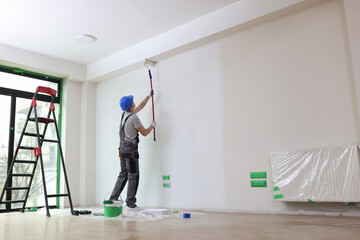Bunbury Painters is a skilled professional who handles various painting jobs. They must be able to address any issues that may arise during the job. This can include contacting a supervisor for assistance.
Individuals who paint often use their artwork to express their personalities. This allows them to overcome shyness and communicate with others. It also helps them reach new skill levels and inspires positive emotions.

As a visual medium, art enhances our environment by encouraging a deeper connection between people and nature. It also inspires new perspectives and encourages individuals to take action to mitigate environmental degradation. Several artists, such as Diane Burko and Olafur Eliasson, have used their talents to raise awareness about ecological issues. Some artists have even taken it further by incorporating the natural environment into their artwork.
The first artistic expressions of the physical environment date back to prehistoric cave paintings. Over time, these expressions have evolved into landscape paintings depicting a physical space from an artist’s viewpoint. These works capture the essence of a place, including its atmosphere and mood. They are often created using different techniques to achieve a desired aesthetic effect.
Painters use various materials to create their artwork, including oil, acrylic, and watercolor. They may also work with other media types like wood or paper. In addition, painters often work in their studios, which provides them with a controlled environment for their creative process. These studios usually have easels, work tables, and storage areas for their tools and supplies.
Artists also prepare material, such as cleaning brushes and priming canvases. They then use various brush strokes and color blending to produce their desired effects. They can also incorporate different textures and layers to add depth and dimension to their creations.
Throughout a project, painters will evaluate and refine their artwork. They will adjust color, composition, and form and may apply a protective coat or varnish to finish the piece. They will then exhibit and sell their creations to the public.
Painters have unique skills that allow them to express their creativity and imagination. They can also manipulate their surroundings and create unique pieces of art that will leave a lasting impression on their audience. They can also exhibit their works in various venues, including art galleries and museums. Although a painter’s job can be highly lucrative, they choose to do so out of their passion for creating.
An artistic hobby like painting can benefit anyone, including children and adults. It helps to hone creative thinking and improves problem-solving skills. It also provides a sense of accomplishment and boosts self-esteem. Moreover, it enhances emotional intelligence, which helps individuals understand their emotions. It also allows them to express their feelings and emotions through the art they create. It is an excellent way to relax and unwind from stressful daily routines.
In addition to sharpening the mind through conceptual visualization and implementation, painting strengthens the brain’s memory recall capabilities. This is particularly beneficial for people who spend their workdays dealing with non-visual information, which can make it difficult to remember visual details later on. For instance, those who paint or draw regularly are less likely to suffer from memory loss illnesses like Alzheimer’s disease.
Moreover, painting can help stroke patients with their motor skills. It can help them regain lost balance and agility. Additionally, it can help them communicate with loved ones. Painting is a great pastime for seniors with cognitive decline, as it can stimulate their memory and encourage verbal skills. It can also stir dormant memories and spark nonverbal expressions such as smiles and laughter.
Furthermore, it can help stroke survivors reminisce about their past. It can also boost their social engagement and overall quality of life. Painting is a great way to relax and relieve stress. It can even help you develop better sleep habits, which benefits your health and well-being. Moreover, it can improve your self-esteem and encourage you to try new things.
While it’s important to know how to mix your paints properly, you must also know the different composition techniques. These techniques can help you create a balanced and aesthetically pleasing painting. Besides this, you should also be familiar with the materials used in artwork. If you’re unfamiliar with the techniques, you should take a class from a professional artist. These classes are available at many independent living, assisted living, and memory care communities.
Painting allows individuals to explore their creative side, a vital component of overall mental health. It also helps individuals develop a sense of mindfulness by requiring them to focus on one object at a time, which can reduce stress levels. Furthermore, it enhances fine motor skills, allowing people to hold and maneuver a paintbrush easily.
In addition, painting can help people express their emotions and thoughts that they may not be able to convey through words. As a result, it can be a healing experience for many individuals of all ages. Moreover, individuals who regularly paint have less exposure to memory loss diseases like Alzheimer’s and dementia as they age.
While creating an art piece, painters must constantly evaluate and adjust their work to ensure the desired outcome matches their original vision. This process can be stressful and frustrating, but it can also lead to improved problem-solving skills. This can help painters become more adaptable in other areas of their lives.
When a person engages in a creative activity, such as painting, the brain’s left and right hemispheres are stimulated. This activity improves cognitive growth and enables individuals to solve problems more efficiently. Moreover, painting triggers the release of endorphins, which are natural mood enhancers. As a result, painters feel happy and positive after their creations are complete.
Painters often display their artwork in art galleries and museums and offer them for sale to the public. They may also reproduce their paintings on other objects, such as greeting cards, stationery, and mugs. They may also use their paintings as a form of therapy by channeling their negative emotions through painting.
Painting is an excellent way to express emotions, especially for individuals who cannot verbally communicate. It promotes openness and self-expression and can be a great source of relaxation. It is also an effective way to relieve stress and improve mental health, particularly for people with anxiety. It is a good alternative to traditional therapy, which can be invasive and unnatural. Painting allows the mind to relax and release negativity, and it can help you to feel more confident about yourself.
Painting enhances the brain’s visual perception skills, boosting spatial awareness and memory recollection. In addition, creating art requires conceptual visualization and implementation, which promotes critical thinking. Additionally, painters learn to work with their mistakes, which helps them develop important problem-solving abilities. For many painters, their paintings are personal, and they do not want to sell them. Nevertheless, if a painter is passionate about their craft, they may share their artwork with others.
Regardless of the art style, it can be a powerful emotional release for both men and women. It can help them overcome their shyness and become more confident. The ability to tell a story through art can help them break down social barriers and make meeting new people easier. In addition, it can help them build trust and improve relationships.
Artistic therapy uses painting to reduce patients’ psychological defenses and allow them to express their real feelings. It can be used with regular therapeutic dialogue, allowing patients to open up and express their emotions. It is a useful tool for those with psychological problems, such as depression or post-traumatic stress disorder.
The benefits of painting are numerous, and it can be a good alternative to traditional therapies. It is a fun, creative activity that stimulates the brain and improves motor skills. It can be done alone or with friends, which is a good way to relieve stress. In addition, it can be a good hobby for young and older adults. It can even be a good source of income.

